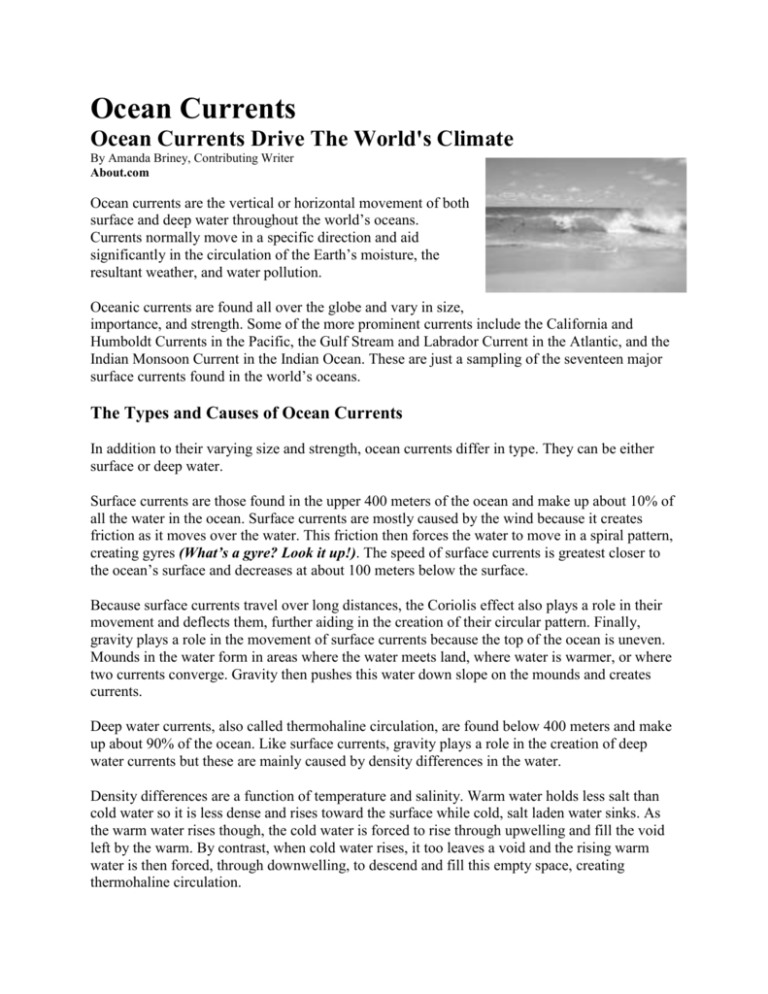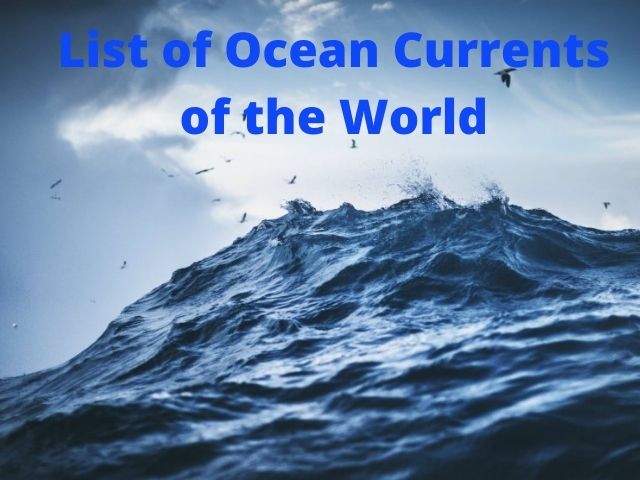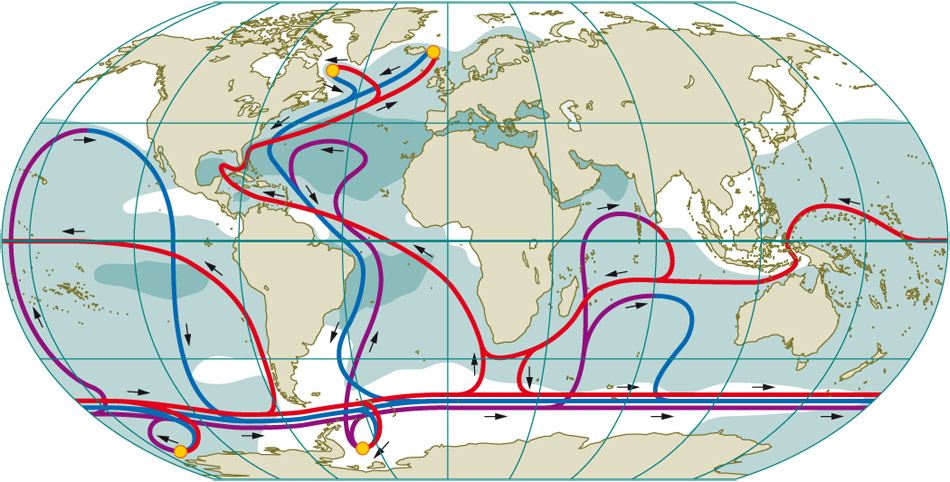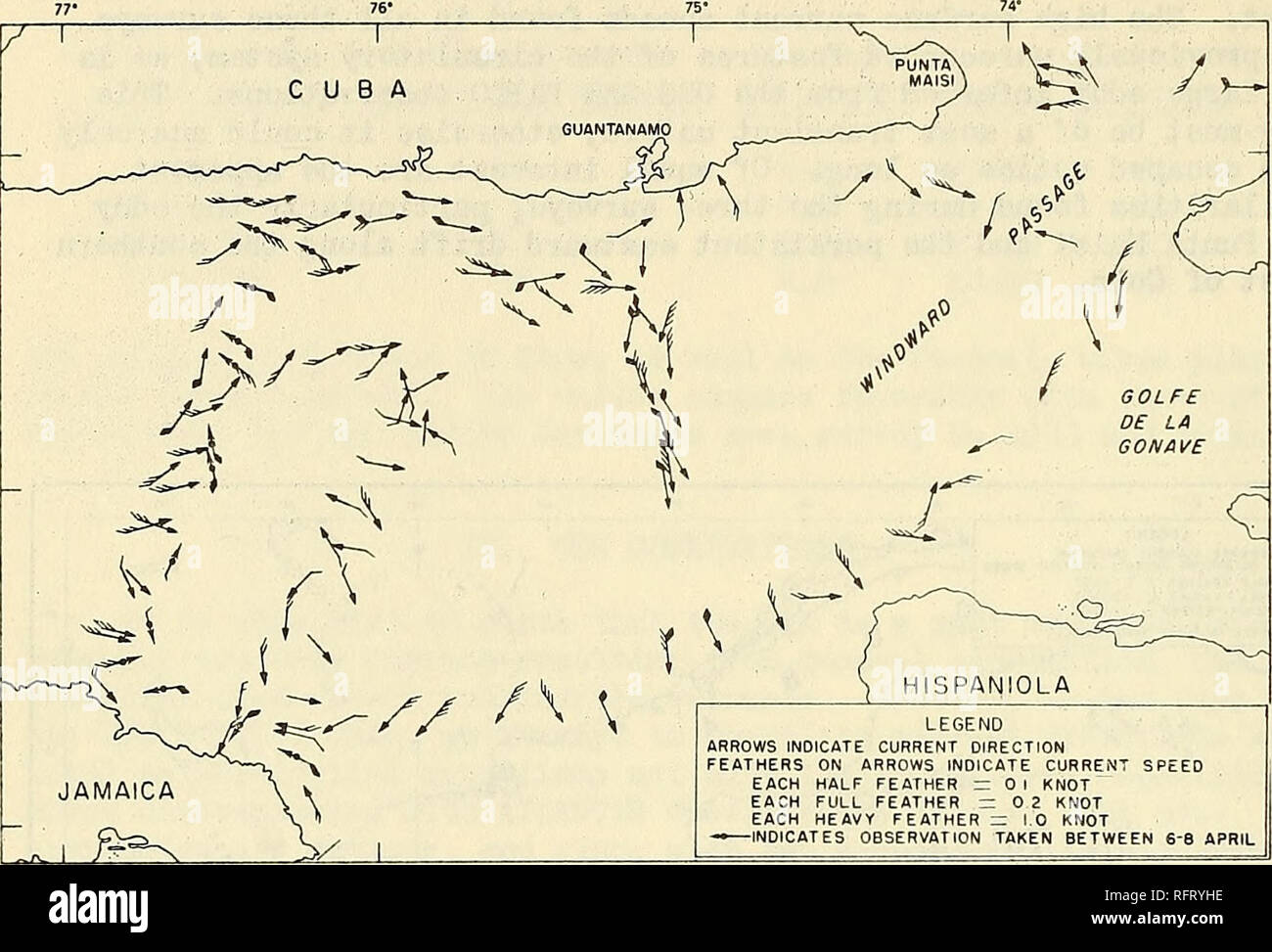39 compare the movement of surface and deep currents
Inside Earth: The Crust, Mantle and Core - Earth How In comparison to other layers, the crust is mostly made up of rocks with a density from 2.7 to 3.3 g/cm 3. The lithosphere is split between continental and oceanic crust. But both turn out to be very different from each other. Oceanic crust. All oceanic crust forms in the same way. First, long chains of underwater volcanoes spew out lava. Plate tectonics - Wikipedia Plate tectonics (from the Late Latin: tectonicus, from the Ancient Greek: τεκτονικός, lit. 'pertaining to building') is the generally accepted scientific theory that considers the Earth's lithosphere to comprise a number of large tectonic plates which have been slowly moving since about 3.4 billion years ago. The model builds on the concept of continental drift, an idea developed ...
Ocean - Wikipedia A map of the global thermohaline circulation; blue represents deep-water currents, whereas red represents surface currents. Types of ocean currents An ocean current is a continuous, directed movement of seawater generated by a number of forces acting upon the water, including wind , the Coriolis effect , temperature and salinity differences. [7]

Compare the movement of surface and deep currents
manoa.hawaii.edu › exploringourfluidearthPhylum Echinodermata | manoa.hawaii.edu/ExploringOurFluidEarth In the echinoderms there are two surfaces. One is the oral surface, where the mouth is and the tube feet project. The tube feet on the oral surface are limited to distinct regions called the ambulacral regions. The other surface is the aboral, which typically contains the anal opening of the digestive system. All echinoderms are variations on ... en.wikipedia.org › wiki › EarthEarth - Wikipedia This gives an apparent movement of the Sun eastward with respect to the stars at a rate of about 1°/day, which is one apparent Sun or Moon diameter every 12 hours. Due to this motion, on average it takes 24 hours—a solar day—for Earth to complete a full rotation about its axis so that the Sun returns to the meridian. The orbital speed of ... Fishing 101: Best Weather and Pressure for ... - US Harbors In conditions of low pressure or those with a pressure less than 29.60, the fishing will be slow. The weather is usually cloudy and rainy, and you will need to target fish near cover or in deep water. As the pressure rises and weather conditions improve, the fish will be a bit more active. Again, you'll want to go after fish in deep water or ...
Compare the movement of surface and deep currents. en.wikipedia.org › wiki › Patch_clampPatch clamp - Wikipedia This leakage can be partially corrected for, however, which offers the opportunity to compare and contrast recordings made from different areas on the cell of interest. Given this, it has been estimated that the loose patch technique can resolve currents smaller than 1 mA/cm 2. Patch-Seq One World Ocean - Activity - TeachEngineering Compare and contrast the properties of salt water in the oceans/seas and freshwater elsewhere on the planet. Describe mixing caused by currents in the ocean, including the effects of warm and cold water as well as surface currents. List several systems that engineers are designing that involve the ocean as a resource. Educational Standards What Are Biotic and Abiotic Factors in an Ecosystem? Ocean currents: Ocean currents involve the movement of water, which in turn facilitates movement of biotic and abiotic factors like organisms and nutrients. Currents also affect water temperature ... manoa.hawaii.edu › exploringourfluidearth › nodeContinental Movement by Plate Tectonics | manoa.hawaii.edu ... Convection currents drive the movement of Earth’s rigid tectonic plates in the planet’s fluid molten mantle. In places where convection currents rise up towards the crust’s surface, tectonic plates move away from each other in a process known as seafloor spreading (Fig. 7.21). Hot magma rises to the crust’s surface, cracks develop in ...
Surf's Up! - Lesson - TeachEngineering Waves, which are regular patterns of motion, can be made in water by disturbing the surface. When waves move across the surface of deep water, the water goes up and down in place; there is no net motion in the direction of the wave except when the water meets a beach. (Note: This grade band endpoint was moved from K-2.) Lake County News,California - Lady of the Lake: Look, look ... Deep water + Wind = Surface Water Movement or Langmuir Circulation ... Epilimnion, is the surface layer and the water here is the warmest (when there is no ice cover) and most active with movement, from wind and surface currents. The layer at the very bottom of a lake or ocean, is very quiet, still, dark, and cold, and called the Hypolimnion. ... Earth's Magnetosphere: Protecting Our Planet from Harmful ... Unlike Mercury, Venus, and Mars, Earth is surrounded by an immense magnetic field called the magnetosphere. Generated by powerful, dynamic forces at the center of our world, our magnetosphere shields us from erosion of our atmosphere by the solar wind (charged particles our Sun continually spews at us), erosion and particle radiation from coronal mass ejections (massive clouds of energetic and ... Convection Current Experiment - The Homeschool Scientist Convection is the transfer of heat by the movement of heated particles into an area of cooler particles. You can experience convection when you light a match. The air directly above the lit match is always hotter than the air around the match. This difference in temperature around the match is caused by the effect of heat on the density of air.
The Movement Of Ocean Water Chapter Study Guide - ProProfs ... Try this amazing The Movement Of Ocean Water Chapter Study Guide quiz which has been attempted 155 times by avid quiz takers. Also explore over 79 similar quizzes in this category. ... What are the differences between the following terms:deep current vs. surface currentel nino vs la ninaspring tide vs neap tidetide and tidal range. 9. What is vertical migration of zooplankton and why does it ... Copepods (shown here) are a type of zooplankton and are a big part of the diel vertical migration. Like other tiny marine animals that share a similar diet, copepods are particularly likely to migrate to surface waters at night and deep water during the day. Image courtesy of NOAA Fisheries Alaska Fisheries Science Center. › classzone-retiredClasszone.com has been retired Connected Teaching and Learning. Connected Teaching and Learning from HMH brings together on-demand professional development, students' assessment data, and relevant practice and instruction. d37iyw84027v1q.cloudfront.net › Common › ISO7010Are your safety signs ISO 7010-compliant? sign, the slippery surface warning sign and the toxic material warning sign. Many more ISO 7010 compliant signs are available and even more signs are still in use that comply with older, non-international norms. Use the following pages to compare warning signs in your facility with the ISO 7010 compliant warning signs.
Best Mattress of 2022 - Expert Reviews For All ... - Sleep.org The Eco Organic Mattress is medium firm (6) and our testers noted gentle cushioning, robust support, and easy movement across the surface. Temperature control is another strong point. We detected very little heat buildup on the surface, and the mattress slept cooler than the majority of foam beds we've tested.
Let the railroad service blame game begin: Analysis - Trains Executives from the big four U.S. railroads — BNSF Railway, CSX Transportation, Norfolk Southern, and Union Pacific — will take turns in the hot seat next week during two days of Surface Transportation Board hearings on widespread service problems. Federal regulators, fed up with ongoing shipper complaints, will want to know how and when the railroads will get their service out
In Depth | Mars - NASA Solar System Exploration Formation. When the solar system settled into its current layout about 4.5 billion years ago, Mars formed when gravity pulled swirling gas and dust in to become the fourth planet from the Sun. Mars is about half the size of Earth, and like its fellow terrestrial planets, it has a central core, a rocky mantle, and a solid crust. Structure.
2. Energy in Physical Processes - Teaching Energy 2.3 Earth's weather and climate are mostly driven by energy from the Sun. For example, unequal warming of Earth's surface and atmosphere by the Sun drives convection within the atmosphere, producing winds, and influencing ocean currents. 2.4 Water plays a major role in the storage and transfer of energy in the Earth system.
Ocean Currents - Shortcut method by to learn faster ... Current temperature: In general, currents in the western part of every continent are cold (the exceptions are mentioned in the article on movements of the ocean water). Currents coming from the polar region are generally cold. Currents near to equator are generally warm. There is a counter-equatorial current, which moves from west to east (warm).
Underground Injection Control Well Classes - US EPA The Underground Injection Control program consists of six classes of injection wells. Each well class is based on the type and depth of the injection activity, and the potential for that injection activity to result in endangerment of a USDW. Class I wells are used to inject hazardous and non-hazardous wastes into deep, isolated rock formations.
What is Plate Tectonics? | Plate Tectonics | Live Science Plate tectonics is the theory that Earth's outer shell is divided into large slabs of solid rock, called "plates," that glide over Earth's mantle, the rocky inner layer above Earth's core ...
Comparison between the effect of commercially available ... Table 1 depicts the surface morphology of the 20 teeth in group A and group B. Group A showed more changes in surface morphology than group B, i.e., 4/10 in group A and 2/10 in group B. Unpaired "t"-test was run and the P value was 0.3544 and results were not statistically significant as shown in Table 2.
Electric Current: What is it? (Formula, Units And AC vs DC ... Electric current is defined as a stream of charged particles—such as electrons or ions—moving through an electrical conductor or space. It is the flow rate of electric charge through a conducting medium with respect to time. Electric current is expressed mathematically (e.g. in formulas) using the symbol "I" or "i".
What's climate change really doing to the ocean? Ask the ... The data collected by these robots enables scientists to observe changes in the deep ocean down to 2000 meters, which would not be possible using satellites that look only at the surface. Since the floats freely drift with ocean currents and move up and down in the water, they also cover broader areas than stationary buoys.
6A: Down to the Deep - The Ocean's Biological Pump Downwelling occurs when surface waters converge (come together), pushing the surface water downwards; regions of low primary productivity because nutrients get used up and are not continuously resupplied by the cold, nutrient-rich water from below the surface. currents occur in areas where cold, denser water sinks. These downwelling currents bring dissolved CO 2 down to the deep ocean.
Plate Boundaries: Convergent, Divergent, and ... - Study.com These currents are the primary driving force behind plate movement. This theory was the result of decades of work and observations made of the earth's surface. ... The first is a deep ocean trench ...
X-Press Pearl Disaster: An Oceanographic ... - Groundviews Figure 1 - Location of the X-Press Pearl and the major currents in the region. The wind and wave directions experienced during the incident are also shown. Impact. It is possible to use computer models to simulate the ocean currents and to track the parcels of water (particle tracking) at the surface that contain the buoyant plastics.
📐Which type of current occurs because of differences in ... What is deep water current. Explanation: When the water molecules of the ocean become heated, they expand. ... Since warmer water thus can hold more salt and other molecules than cold water; it can have a higher salinity. To relate this to ocean currents, the higher the salinity of ocean water, the more dense it becomes.
d6cwmg2kst3of.cloudfront.net › documents › guide4th grade Energy & Waves disturbing the surface. When waves move across the surface of deep water, the water goes up and down in place; it does not move in the direction of the wave except when the water meets the beach. • Waves of the same type can differ in amplitude (height of the wave) and wavelength (spacing between wave peaks). 6* ,8
What are Ocean Currents? - Definition & Types - Video ... These ocean currents, which are massive currents that are influenced by a variety of different forces that act to propel the water both on the surface and in deep ocean waters. This movement has a ...
In Depth | Earth - NASA Solar System Exploration Earthquakes result when plates grind past one another, ride up over one another, collide to make mountains, or split and separate. Earth's global ocean, which covers nearly 70% of the planet's surface, has an average depth of about 2.5 miles (4 kilometers) and contains 97% of Earth's water.
Unit 8 Reading - Student Materials Figure 4. Simple representation of the major surface ocean currents in the North Atlantic. Red arrows are warm currents, blue are cold currents and black arrows are neutral in terms of movement of heat. The primary location of the North Atlantic Deep Water (NADW) formation is shown by the blue ellipse.
Fishing 101: Best Weather and Pressure for ... - US Harbors In conditions of low pressure or those with a pressure less than 29.60, the fishing will be slow. The weather is usually cloudy and rainy, and you will need to target fish near cover or in deep water. As the pressure rises and weather conditions improve, the fish will be a bit more active. Again, you'll want to go after fish in deep water or ...
en.wikipedia.org › wiki › EarthEarth - Wikipedia This gives an apparent movement of the Sun eastward with respect to the stars at a rate of about 1°/day, which is one apparent Sun or Moon diameter every 12 hours. Due to this motion, on average it takes 24 hours—a solar day—for Earth to complete a full rotation about its axis so that the Sun returns to the meridian. The orbital speed of ...
manoa.hawaii.edu › exploringourfluidearthPhylum Echinodermata | manoa.hawaii.edu/ExploringOurFluidEarth In the echinoderms there are two surfaces. One is the oral surface, where the mouth is and the tube feet project. The tube feet on the oral surface are limited to distinct regions called the ambulacral regions. The other surface is the aboral, which typically contains the anal opening of the digestive system. All echinoderms are variations on ...




















/https://tf-cmsv2-smithsonianmag-media.s3.amazonaws.com/filer/69/64/6964ec42-f74e-41eb-a7bd-4d2939689bd1/atlantic_currents.jpg)














0 Response to "39 compare the movement of surface and deep currents"
Post a Comment